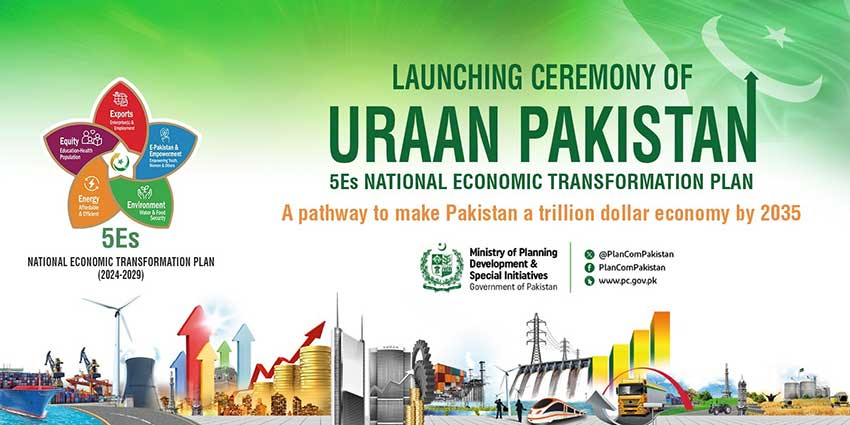By Muhammad Mohsin Iqbal
The 13th Five-Year Plan (2024-2029), aptly titled “Uraan Pakistan,” represents a bold and comprehensive strategy aimed at steering Pakistan towards sustainable development, economic resilience, and societal progress. At a critical crossroads in its history, Pakistan seeks to leverage lessons from earlier plans while addressing systemic obstacles that have previously impeded progress. By critically analyzing past shortcomings, this new plan aspires to achieve transformative growth and equitable development.
The subsequent Five-Year Plans, particularly the 11th (2013-2018) and 12th (2018-2023), sought to build upon these earlier efforts by emphasizing economic growth, infrastructure development, and social welfare. The 11th Plan prioritized macroeconomic stability, industrial expansion, and human resource development. Reforms targeting energy, education, and health sectors yielded incremental successes, yet the plan’s broader objectives were hampered by political turbulence, economic unpredictability, and gaps in policy execution. Key areas such as energy crises, underfunded human capital, and delayed infrastructure projects remained unresolved.
The 12th Plan aimed to stabilize the economy, reduce poverty, and enhance governance. However, its ambitious target of achieving 7-8% annual GDP growth was derailed by external and internal factors, including the COVID-19 pandemic, which devastated the global economy. Inflation, rising fiscal deficits, and insufficient foreign direct investment further compounded these challenges. Despite setbacks, advancements in health and education provided a silver lining. Yet, structural flaws such as corruption, mismanagement, and ineffective policy implementation continued to hinder progress.
A recurring theme in the incomplete implementation of past plans has been political instability and lack of continuity in governance. Successive administrations often sidelined or revised existing plans, leading to fragmented efforts and inconsistent execution. Governance inefficiencies, bureaucratic red tape, and corruption have also played significant roles in undermining developmental initiatives. Delays in infrastructure projects, poor interdepartmental coordination, and inadequate resource allocation have been persistent obstacles. Moreover, the absence of robust accountability mechanisms allowed inefficiencies to persist unchecked.
Economic challenges have further exacerbated these issues. Pakistan’s reliance on foreign loans and aid has left it vulnerable to global economic fluctuations. High levels of external debt, an unstable currency, and an underdeveloped industrial base have constrained the country’s capacity for self-sustained growth. Persistent trade deficits and low export volumes have compounded these problems, making it difficult to achieve ambitious growth targets.
Despite these hurdles, the 13th Five-Year Plan, “Uraan Pakistan,” offers a renewed vision for a brighter future. Its central focus is on fostering a knowledge-based economy, promoting environmental sustainability, and enhancing social infrastructure. By prioritizing innovation, digital transformation, and sectoral advancements in information technology, renewable energy, and agriculture, the plan seeks to position Pakistan as a competitive player in the global economy. Key initiatives aim to improve healthcare and education systems, empowering youth to contribute meaningfully to the nation’s development.
A defining feature of the 13th Plan is its emphasis on inclusive growth. The plan aspires to ensure that developmental benefits reach all segments of society, particularly marginalized groups such as women and rural communities. By addressing issues of poverty, job creation, and social mobility, the plan aims to create a more equitable distribution of resources. Recognizing the pressing challenge of climate change, it incorporates measures to promote green technologies, water conservation, and sustainable agricultural practices. Environmental stewardship is central to the plan’s vision, reflecting Pakistan’s commitment to combating pollution, deforestation, and resource depletion.
However, the success of “Uraan Pakistan” hinges on addressing past mistakes and fostering a culture of accountability and good governance. The lessons from earlier plans underscore the importance of political stability and policy continuity. Achieving the plan’s objectives will require a unified approach involving federal and provincial governments, private sector stakeholders, and civil society organizations. Strengthening governance frameworks, combating corruption, and implementing transparent monitoring mechanisms are essential to prevent delays and inefficiencies.
Economic sustainability is another critical area that demands attention. Reducing reliance on foreign debt and promoting domestic industrial growth are imperative for long-term stability. The plan must prioritize building a robust, export-oriented economy driven by innovation and technology. Efficient and transparent allocation of financial resources, coupled with rigorous oversight, will be crucial for achieving the desired outcomes.
Moreover, the government must focus on fostering an enabling environment for private sector participation. Public-private partnerships can play a pivotal role in accelerating infrastructure development and technological innovation. Encouraging investments in renewable energy, digital infrastructure, and skill development will help create a more resilient and competitive economy.
Education and healthcare remain central to the 13th Plan’s vision. By investing in quality education and vocational training, the government can equip the workforce with the skills needed for a rapidly evolving global economy. Simultaneously, strengthening the healthcare system through increased funding, improved access, and better facilities will enhance overall societal well-being and productivity.
Environmental sustainability, a cornerstone of “Uraan Pakistan,” requires a concerted effort to address pressing challenges. Developing and implementing policies for water conservation, afforestation, and renewable energy adoption will help mitigate the adverse effects of climate change. Collaborating with international partners and leveraging global best practices can further strengthen Pakistan’s environmental strategy.
In conclusion, the 13th Five-Year Plan represents a beacon of hope for Pakistan’s future. By learning from past experiences and adopting a holistic approach, “Uraan Pakistan” has the potential to transform the nation into a model of sustainable development and inclusive growth. Achieving this vision will require unwavering political will, effective governance, and active participation from all sectors of society. Through collective effort and a commitment to progress, Pakistan can soar to new heights of prosperity, fulfilling the aspirations of its people and securing a brighter future for generations to come.


